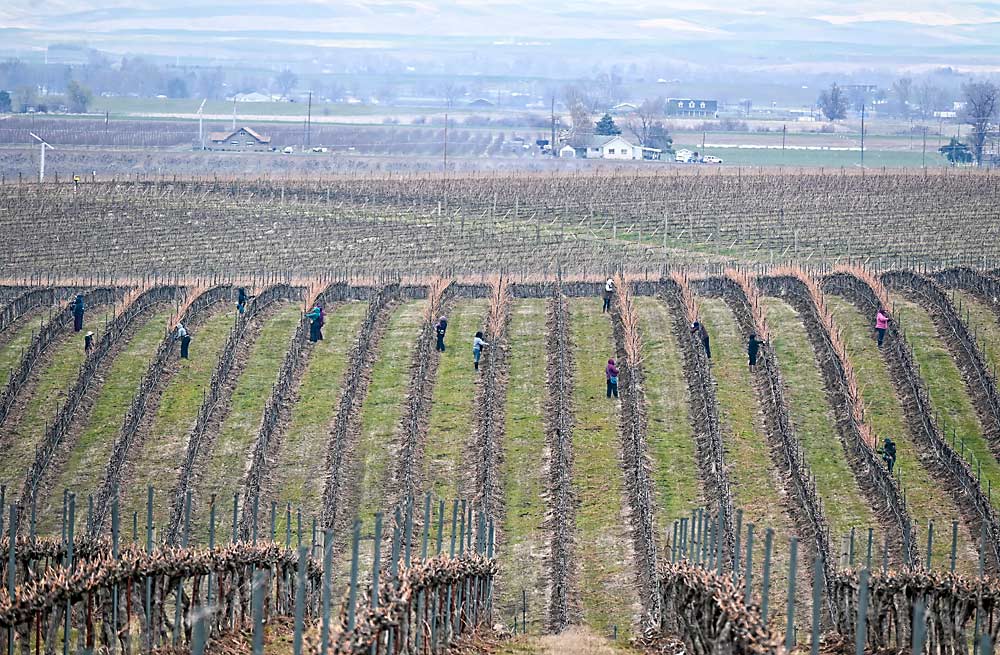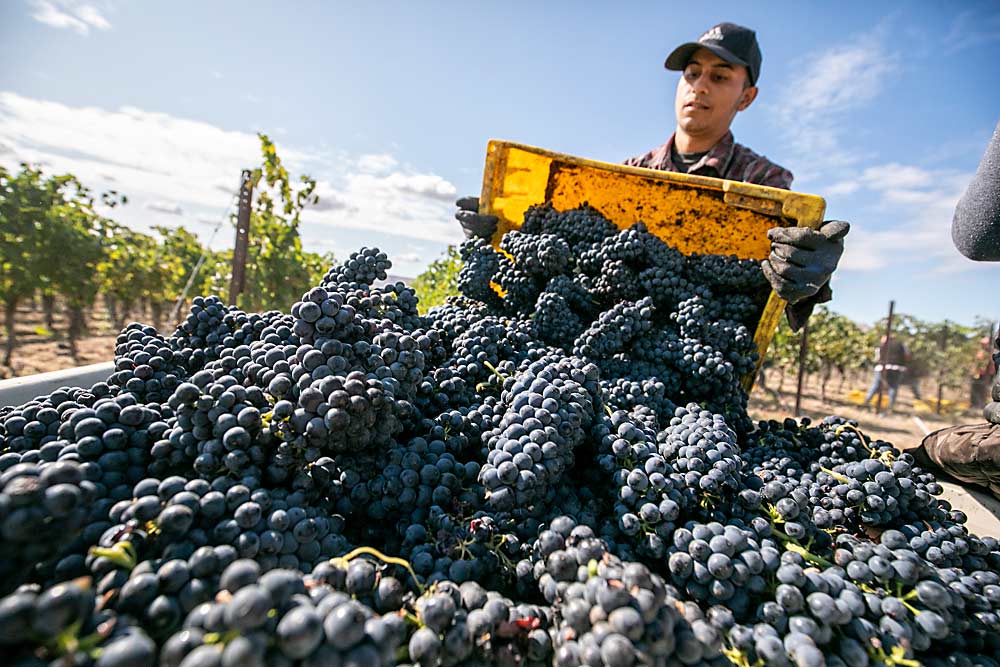
While many Washington wine grape growers see mechanization as a strategy to combat a worsening labor shortage, there are others who would rather forgo mechanizing certain tasks in order to retain the skilled workers they rely on for others.
Mechanization tools — and growers’ understanding of how best to use them — have come a long way when it comes to quality, but some wineries still want as much hands-on labor as they can afford. So, Good Fruit Grower asked two Northwest growers who manage high-end vineyards for boutique wineries how they approach the selective adoption of mechanization to improve the performance of, rather than replace, their workforce.
“For someone like me, I can’t fully mechanize any one job because I would have to lay people off,” said Sadie Drury, general manager for North Slope Management in Walla Walla. “From the day we hire people to start pruning, to the day the last thing is picked, my goal is not to lay anybody off during that time.”
Hand-picking remains prized by some high-end wineries, but it’s also more practical in her patchwork of small picks that serve boutique wineries she farms for at SeVein Vineyards, located on the Oregon side of the Walla Walla Valley.
On Washington’s Red Mountain, custom farmer Dick Boushey also manages 11 vineyards for different wineries, many of whom aren’t set up to handle mechanically harvested grapes, because they need to haul the fruit to their winery in Western Washington, for example, or they want to make whole-cluster wine. Beyond harvest, the wineries he works for want detailed canopy management. Keeping enough people to do that detail work forced him to mechanize more basic tasks in the past few years, he said.
“I didn’t want to mechanize to take work away from people; now there just aren’t enough people,” said Boushey, who also farms his own vineyards nearby in the Yakima Valley. “Now, I’ve got to keep my core people doing the skilled jobs, like thinning, detailed shoot thinning and detailed pruning.”
Switching to more machine harvest would force him to lay off workers, who would likely go pick apples instead, and he might have trouble getting them back as labor shortages push wages up in the tree fruit industry as well. “My advantage is I try to keep them full time,” he said of his crew of about 45.

Mechanizing more tasks and reducing full-time crews, on the other hand, leaves growers with occasional gaps to contend with: high needs for wire lifting and very few for harvest. That’s increasing the grape industry’s reliance on less experienced labor contractors to fill those gaps, Boushey said. He’d rather rely on the crews he’s trained and who know his vineyards as much as possible, but it’s not always easy.
Drury said that using one crew — 40 workers in her case — consistently throughout the season means balancing and prioritizing the schedule of tasks across the more than 300 acres of vineyards she manages.
“Every day I am making timing decisions of which blocks can wait and which blocks need to go right away,” Drury said. “You never have enough people to do all the jobs at a perfect time, so you have to put the puzzle pieces together.”
Mechanization plays an important role in keeping that balance, with buy-in needed from both winemakers and workers — workers who worry about being replaced.
“Whatever tool I get, I have to do it in a way that my crew feels like I am not replacing them, and the quality is not harmed,” she said. “I think they care about quality as much as I do and the winemakers do.”
Both Boushey and Drury use a mechanical pre-pruner, which clears out the long canes and makes the job of pruning easier. “Otherwise, it’s like hand-to-hand combat, pulling out the tendrils,” Boushey said. “Now they just walk through and detail it, so they like it a lot.”
Mechanical suckering or trunk scrubbing was also an easy sell, replacing a tedious and brutal job.
Drury calls the mechanized deleafer “qualitatively the best tool we own,” but it’s also the one with which she has had the most pushback, because the resulting open canopy looks a little rough. In high-end Cabernet Sauvignon, her crew still pulls leaves by hand, because the machine can’t run on their sprawl-style canopy. But they run the deleafer in other blocks, which are later touched up by hand. The deleafer allows her to get more blocks done in the optimum window when they need to get done, she said.
Boushey bought a hedger last season, even though he didn’t want to. Late snow left soils saturated, and vigorous canopy growth followed.
“I’ve always said that if you are buying a hedger, something is out of balance. If you have too much growth, you are not doing something right,” he said, referring specifically to deficit-irrigation-controlled vineyards in Eastern Washington. Hedging is more common in Europe and in California’s Napa Valley, where it rains more. He was pleased with the results in some targeted cases, and the rows looked neatly landscaped, but not all of his winemakers liked it. It’s a targeted tool he hopes not to use much in the future.
What else would they buy? Drury said she would like to add another deleafer, to give her the ability to cover more acreage. Boushey said he’d love to buy one of the new autonomous weeders that have recently debuted in European vineyards. He grows his juice grapes organically, and a robotic weeder would be a huge asset. •
—by Kate Prengaman
Related:
—The margins of mechanization






Leave A Comment